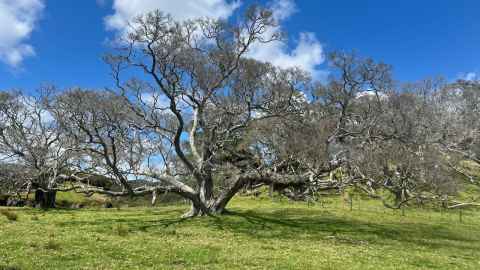Can we buy time to save our native trees?
30 May 2025
Three documentaries exploring myrtle rust and kauri dieback disease will be screened at an Eco Film Festival in Auckland on 7 June.

Myrtle rust poses a risk of wiping out New Zealand’s Christmas tree, the pōhutukawa, and could harm manuka honey production, says Dr Mark Harvey from the University of Auckland.
“It’s destroying whole forest areas and causing a decline in native insects and birds that rely on those habitats,” says Harvey.
He’s a senior lecturer in Te Putahi Mātauranga (Faculty of Arts and Education), and with Marie McEntee and Natasha Matamua-Tassell, was co-lead of Mobilising for Action in the National Science Challenge, a programme which funded artistic research into the threats posed by myrtle rust and kauri dieback.
Harvey will introduce three documentaries created through the programme at a free Eco Film Festival at Auckland’s Academy Cinemas on 7 June.
He hopes the film screening might inspire people to take actions that “buy time” for kauri and native myrtles to adapt, or for the development of treatments for kauri dieback and myrtle rust.
The fungal pathogen myrtle rust was first spotted in Aotearoa in 2017 and has quickly spread through the North Island and parts of the South Island, says Harvey.

The short documentary, Mate Tipu, Mate Rākau (2021), produced and directed by videographer Fiona Apanui-Kupenga (Ngāti Porou), zooms in on the threat myrtle rust poses to our 15 native myrtle species.
The small native tree, ramarama, has already disappeared from the East Coast of the North Island, Department of Conservation ranger Graeme Atkins (Ngāti Porou, Rongomaiwahine), reveals in the film.
“Rōhutu and maire tawake are two other native myrtle species that are getting hammered by myrtle rust, so we’re at risk of losing them.
“Our iconic pōhutukawa trees and manuka can be attacked too and that puts the manuka honey industry at risk,” says Harvey.
With his collaborators he commissioned the short film Saving Our Myrtles (2024), produced by Apanui-Kupenga and directed by Kaea Hills.
It focuses on an East Coast community myrtle rust surveillance project - Te Whakapae Ururoa.
“They’re telling their success story and how it has mobilised them,” says Harvey.

Re: news produced The fight to save kauri with mātauranga Māori (2021), a short film exploring Māori solutions for kauri dieback disease in the Waitākere ranges in West Auckland.
A rāhui imposed to close tracks with infected kauri has proved effective at stopping the disease from spreading in those areas, says Harvey.
“Pseudo-science has been circulating and some local people have been resisting the rāhui and refusing to clean their shoes, which is sad because it’s working,” he says.
Since kauri dieback was first found in New Zealand in the 1970s, it has killed about 11 percent of the giant native trees.
Humans are the main vector spreading the disease, with approximately 71 percent of kauri dieback zones within 50 metres of a track in the Waitakere ranges, says Harvey.
He hopes the films featured in the festival will raise awareness of the problems and the urgent need for more government funding for research that might help save New Zealand’s native trees.
The three documentaries highlight the importance of Māori voices in decision-making on environmental challenges, Harvey says.
“We can’t ignore Māori voices. We’re seeing successful solutions from combining mātauranga Māori and western science.”
People can help prevent the spread of kauri dieback by respecting the rāhui, fencing off kauri on private properties, getting sick trees checked by Auckland Council, and bringing in experts to treat kauri dieback with phosphite injections.
Recording sightings of myrtle rust on the iNaturalist app helps to map its spread.
“Lillypilly is an exotic myrtle and a super-spreader of myrtle rust, so it’s wise to get rid of it,” says Harvey.
Organised by the University of Auckland’s Centre for Climate, Biodiversity and Society – Ngā Ara Whetū, the free Eco Film Festival is at Academy Cinemas in Auckland on 7 June. It features Aotearoa and Pacific films Mate Tipu, Mate Rākau, Saving Our Myrtles, Journey for Justice, and Seasick, at 11am; Thank you for the Rain at 1.30 pm; and Climate Refugees at 3.30pm. Register here.
Media contact
Rose Davis | Research communications adviser
M: 027 568 2715
E: rose.davis@auckland.ac.nz.